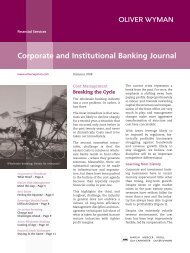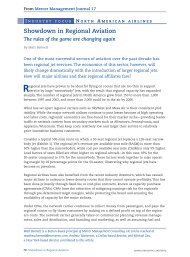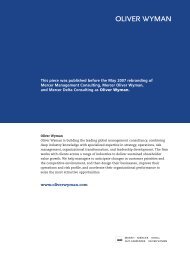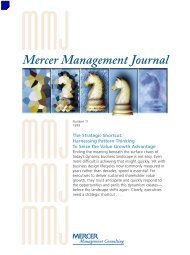Download the Report - Oliver Wyman
Download the Report - Oliver Wyman
Download the Report - Oliver Wyman
You also want an ePaper? Increase the reach of your titles
YUMPU automatically turns print PDFs into web optimized ePapers that Google loves.
Answering those questions, and <strong>the</strong>n putting <strong>the</strong> information to good use, requires an innovative<br />
yet disciplined approach to corporate portfolio strategy. The senior management team must systematically<br />
drive value growth through a wide range of diverse operations, recognizing <strong>the</strong> broadscale<br />
opportunities and risks without losing sight of <strong>the</strong> crucial differences among businesses.<br />
This emerging discipline for driving portfolio growth departs from traditional portfolio thinking.<br />
Flaws in <strong>the</strong> traditional tools<br />
The traditional approach to portfolio management has typically emphasized a role for <strong>the</strong> corporate<br />
center in active financial management or in driving operational excellence through corporate-run<br />
processes.<br />
At <strong>the</strong> extreme, financial management assumes <strong>the</strong> role of a holding company, involving a highly<br />
decentralized, non-interventionist style of management. The CEO and <strong>the</strong> senior management<br />
team take on <strong>the</strong> role of investors, buying and selling businesses based on <strong>the</strong>ir financial attractiveness<br />
using traditional investment ratios and metrics: ROI, revenue and margin growth, and<br />
so on. The operational excellence approach, by contrast, emphasizes improving divisional profit<br />
margins through quality programs, centralized services, reduction in overhead costs, and unified<br />
controls over budgeting, cash flow, and capital management.<br />
Both approaches offer benefits, to be sure. Instituting across-<strong>the</strong>-board financial controls<br />
is often a necessary step, one that may yield a harvest of low-hanging fruit in <strong>the</strong> form of<br />
enhanced efficiencies, process simplification, and staff reductions. Margins are likely to improve.<br />
However, our experience indicates that financial information typically provides a weak platform<br />
from which to map growth opportunities. Corporations developed on this basis tend to build a<br />
portfolio of high-share, high-volume growth businesses that are unrelated to one ano<strong>the</strong>r. The<br />
result is a collection of business unit “silos” that do little to share <strong>the</strong>ir combined reach and customer<br />
knowledge. The basic leadership message is, “Give me 15 percent growth. I don’t care how<br />
you do it.”<br />
The operational excellence model, for its part, can achieve incremental gains. But once those<br />
improvements are exhausted, this approach fails to provide a platform for future growth.<br />
Both of <strong>the</strong>se approaches, moreover, tend to be backward-looking, focusing on past financial<br />
performance ra<strong>the</strong>r than present and future customer and marketplace dynamics. They tend<br />
to direct your thinking inward, on what you do best, on <strong>the</strong> products you make, on reducing your<br />
costs, or building synergies across <strong>the</strong> businesses you already have. This inside-out perspective is<br />
ill-suited to help identify changing patterns of strategic risk, such as when business models are<br />
in danger of becoming obsolete. They also fail to identify <strong>the</strong> white spaces of opportunity. And by<br />
restricting <strong>the</strong> discussion to financial performance, <strong>the</strong>y leave <strong>the</strong> CEO and senior management<br />
team without a vocabulary to articulate <strong>the</strong> common <strong>the</strong>mes that unite <strong>the</strong> company’s many<br />
operations, making it very difficult to formulate and communicate a forward-looking strategic<br />
message about adaptation and growth.<br />
To effectively manage strategic risk and define growth opportunities in rapidly changing markets,<br />
today’s executives need a more powerful, indeed strategic approach, with tools capable of sensing<br />
new shifts in <strong>the</strong> competitive landscape and anticipating where <strong>the</strong> next profit zones will be.<br />
Mercer Management Journal Portfolio redesign 3
















